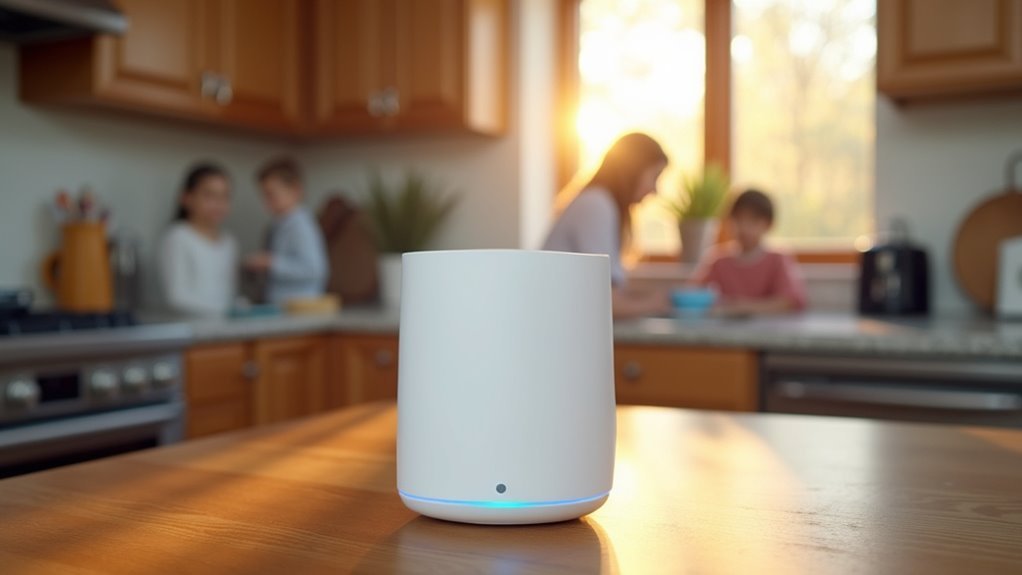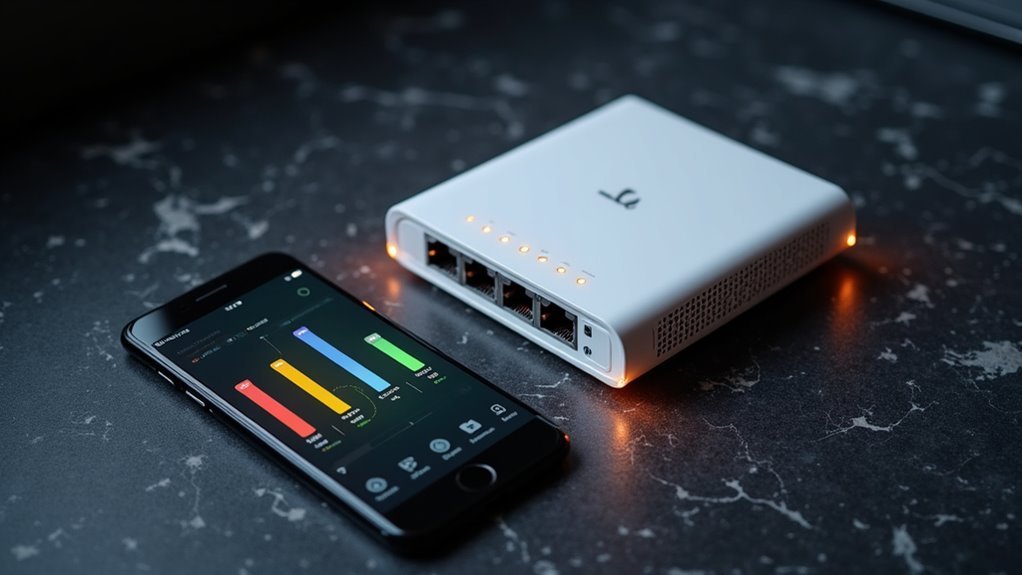You’re probably wasting more energy on your mesh WiFi network than you realize, and with electricity costs climbing, it’s time to make a smarter choice. Modern mesh systems can greatly reduce your power consumption while delivering better coverage and performance than older routers. The key lies in finding networks with intelligent power management, adaptive bandwidth technology, and energy monitoring features that actually work in real-world conditions.
Eero 7: Smart Power Management for Busy Households

When you’re managing a busy household with multiple devices constantly connected to your network, the Eero 7’s smart power management system automatically adjusts energy consumption based on real-time usage patterns.
You’ll benefit from efficient processors that maintain peak Wi-Fi performance across multiple devices without wasting energy. The router handles multiple 4K video streams simultaneously, eliminating energy-draining buffering issues that plague less capable systems.
Efficient processors deliver peak Wi-Fi performance across multiple devices while eliminating energy-wasting buffering during simultaneous 4K streaming.
Through the intuitive app, you can monitor network settings and gain valuable insights into your power usage patterns. This transparency helps you select appropriate energy-saving options for your household’s needs.
The Eero 7’s implementation of WPA3 and advanced network security protocols doesn’t compromise efficiency, ensuring your connected home remains both secure and energy-conscious.
TP-Link Deco BE63: Wi-Fi 7 Efficiency for High-Speed Networks
As your smart home ecosystem expands, the TP-Link Deco BE63’s Wi-Fi 7 technology delivers unprecedented efficiency through faster data transmission that actually reduces energy consumption during high-speed internet usage.
You’ll maximize network performance while managing multi-gigabit speeds across numerous connected devices without significant energy waste.
The system’s five 2.5 GbE Ethernet ports provide efficient wired connections that consume less power than wireless alternatives.
You’ll benefit from automatic channel selection and smart band steering that optimize performance while minimizing energy requirements for maintaining stable connections.
Through the intuitive app’s user-friendly setup, you can monitor and control energy usage monitoring effectively.
This guarantees your network operates at peak efficiency without unnecessary power draw, making it perfect for bandwidth-intensive households prioritizing both performance and energy conservation.
TP-Link Deco S4: Budget-Friendly Low Power Consumption

Not every household needs cutting-edge Wi-Fi 7 speeds to achieve excellent energy efficiency. The TP-Link Deco S4 proves this by delivering exceptional low power consumption at just $100, making it an ideal budget mesh solution for energy-conscious homes.
This system provides strong connectivity across homes over 3,000 square feet while maintaining impressive wireless coverage.
You’ll appreciate how it handles up to 50 devices simultaneously while intelligently managing power consumption. The Deco S4 optimizes energy usage by dynamically adjusting power based on your network’s demand, ensuring you’re not wasting electricity during lighter usage periods.
Quick installation minimizes setup energy consumption, and with support for broadband speeds up to 500 Mbps, you get excellent energy efficiency without compromising performance for typical household needs.
Adaptive Bandwidth Technology Reduces Energy Waste
While traditional Wi-Fi systems blast signals at constant power levels regardless of actual demand, adaptive bandwidth technology revolutionizes energy efficiency by intelligently scaling power output based on real-time network activity.
Your mesh Wi-Fi systems automatically adjust signal strength and frequency allocation, delivering energy savings up to 30% compared to conventional networks.
This smart approach provides three key benefits for your smart homes:
- Dynamic power scaling – Signal strength adjusts based on connected devices and usage patterns
- Device prioritization – High-demand devices receive necessary resources while low-priority devices consume less power
- Performance optimization – Network efficiency improves without sacrificing connectivity quality
You’ll reduce energy waste during idle periods and low-usage times, contributing to smaller carbon footprints while maintaining excellent performance across all devices.
Energy Monitoring Features and Power Optimization Settings

Beyond automatic power scaling, today’s mesh WiFi systems include extensive energy monitoring features that give you real-time visibility into your network’s power consumption patterns. You can track usage data and implement power optimization settings to achieve significant energy savings across your mesh networks.
| Feature | Energy Benefit |
|---|---|
| Wi-Fi scheduling features | Turn off network during unused hours |
| Automatic power adjustment | Reduces output during low-traffic times |
| Device prioritization | Optimizes bandwidth for reduced energy usage |
The Asus ZenWiFi AX exemplifies these capabilities with its power-saving mode that intelligently adjusts output based on network demand. Combined with automatic firmware updates that maintain peak efficiency, these systems help you minimize energy waste while preserving performance quality throughout your home network.
Frequently Asked Questions
Does Mesh Wifi Use a Lot of Power?
Yes, you’ll find mesh WiFi uses more power than traditional routers since you’re running multiple nodes. You’ll typically consume 30-150 watts total, costing you around $20-30 annually in electricity.
What Is the Best Mesh Network for a House?
You’ll want the Asus ZenWiFi BQ16 Pro for premium performance at $949.99, or choose the budget-friendly TP-Link Deco BE63 at $299.99 for excellent Wi-Fi 7 coverage in large homes.
Should I Get Wifi 5 or 6 Mesh?
You should get Wi-Fi 6 mesh for faster speeds, better device handling, and future-proofing. It’s more expensive than Wi-Fi 5, but you’ll benefit from improved performance and capacity.
What Must Be Avoided in a Mesh Network?
You must avoid placing nodes behind thick walls, spacing them over 30 feet apart, using outdated firmware, overloading single nodes with devices, and frequently rebooting manually instead of relying on automatic optimization.





Leave a Reply